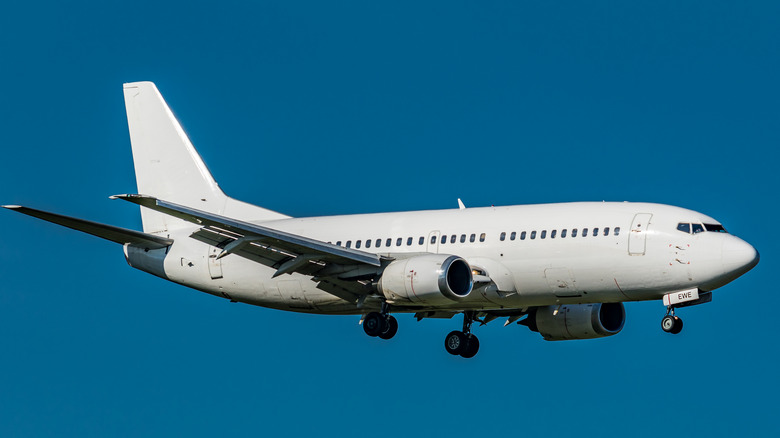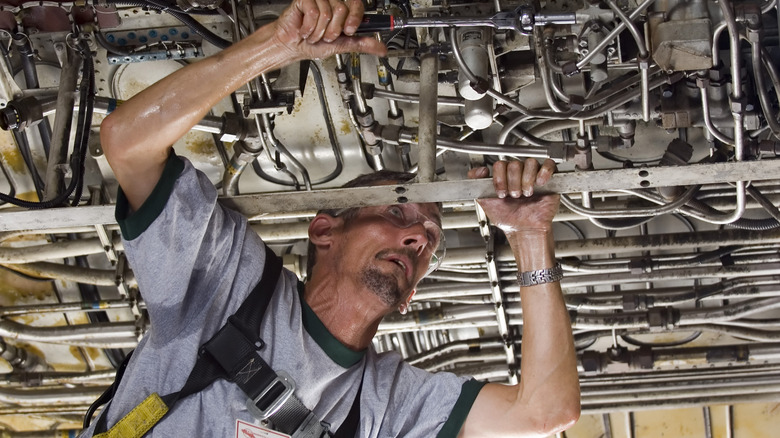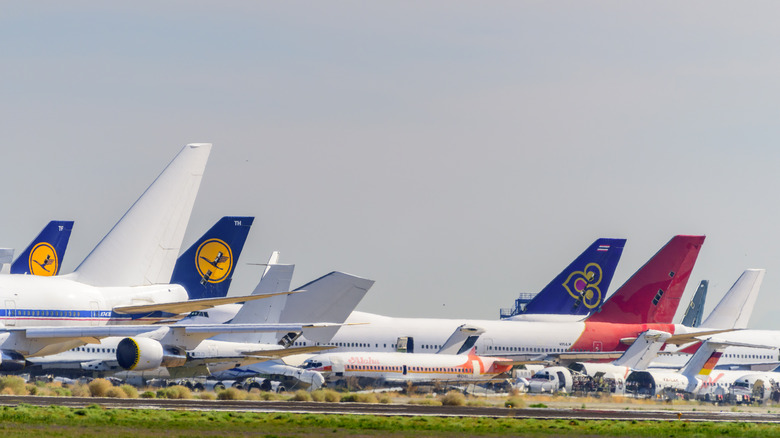How Long Does The Average Boeing Plane Stay In Service?
The Canadian carrier Nolinor Aviation operates a fleet of Boeing 737s with an average age of 44.4 years, making it one of the oldest Boeing fleets on the planet. But is this a true representation of how long the average Boeing plane stays in service? The answer is no, Nolinor is very much an outlier when it comes to the average Boeing aircraft. But before we explore this in more detail, let's just clarify that this article focuses on commercial aircraft and therefore we can exclude the legendary Boeing B-52 bomber, which may see 100 years of service.
It's also useful to define what we mean by age. Whilst counting years is obviously correct, from a technical standpoint, the age of an aircraft is more accurately measured in flight cycles and flight hours. A flight cycle counts each takeoff and landing as one. It's the pressurization of the cabin and subsequent depressurizing that can stress a passenger jet's airframe. Equally, time in the air is also a factor.
According to Boeing's own analysis of retirement data, passenger jets are typically withdrawn from service after around 26 years — though the range can stretch from as little as five to as many as 50 years. Narrow-body models such as the Boeing 737 Max usually reach that point sooner because of more flight cycles (about 50,000), while long-haul aircraft like the 777 or 787 often remain in service longer (25,000 to 45,000 flight cycles). Boeing's study also notes that economics, not airframe fatigue, usually determines when an aircraft is retired.
The inspections that keep Boeing aircraft flying
Like most mechanical things, the key to a long and healthy service life is proper maintenance. This is especially true of aircraft, where the consequences of getting it wrong can be disastrous. For Boeing aircraft to operate for decades, this longevity relies on meticulously following the required maintenance program. Every commercial jet operates on a maintenance and inspections schedule that increases in depth and complexity as the plane ages.
The most intensive of these are known as "D checks". The all-important D check involves stripping the jet down to its framework so that engineers can check every inch for corrosion or signs of metal fatigue. Depending on the model and its service history, a check like this will typically occur every six to ten years and can take up to 50,000 labor hours to complete.
To find tiny cracks or signs of fatigue, engineers use non-destructive methods like eddy current testing, ultrasonic scanning, and magnetic particle inspection. Airlines may also have to comply with Airworthiness Directives and service bulletins from Boeing, these specify extra — often compulsory work — which address extra risks as they're identified. Among the FAA rules that manufacturers must adhere to is publishing a Limit of Validity (LOV). This defines, in flight cycles or flight hours, how long an aircraft's structural maintenance data remains valid before widespread damage could occur. Once the LOV is reached, the plane can only continue operating if additional inspection programs are approved.
From flight to retirement
Perhaps surprisingly, despite Boeing's assertion that aircraft will happily fly for a quarter of a century or so, many are retired before they reach this milestone. According to Mark Gregory, managing director of Air Salvage International, the average age of airliners scrapped today is about 18 years. Speaking to CNN, he said, "This is already well below the theoretical operational life they have been designed for, but in some occasions we have dismantled aircraft that were not even 10 years old."
However, although many of these jets will end up in aircraft "graveyards" where they'll spend their retirement basking happily in the desert sun, this isn't always the case. A financial industry has grown up around the disposal and recycling of retired jetliners, with hedge funds and specialized investment firms operating in the sector. While most of the recycling value is in the engines, about 80-85% of a commercial aircraft's materials can be recycled. In some instances, this figure can be as high as 99%.
This is important, as over 800 commercial aircraft are expected to be retired in 2025, and by 2050, the annual retirement rate of jetliners is expected to be over 1,200 per year. As commercial fleets evolve and new models enter service, the end of an aircraft's flying life doesn't always signal the end. Thousands of retired Boeing aircraft are continuing to support their still flying brethren long after their final flight. Or maybe that soda-can you just drank from was once part of a proud 747 streaking through the air.


